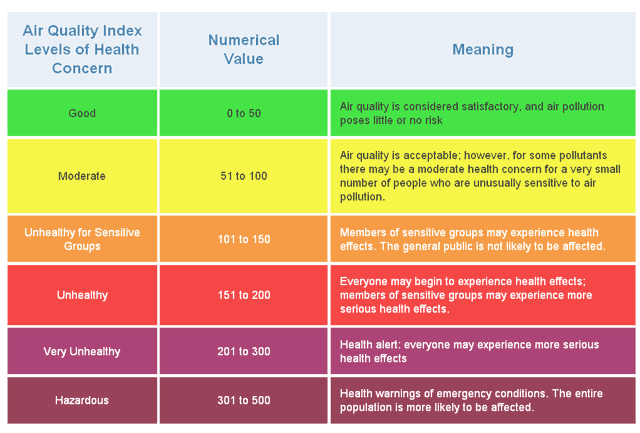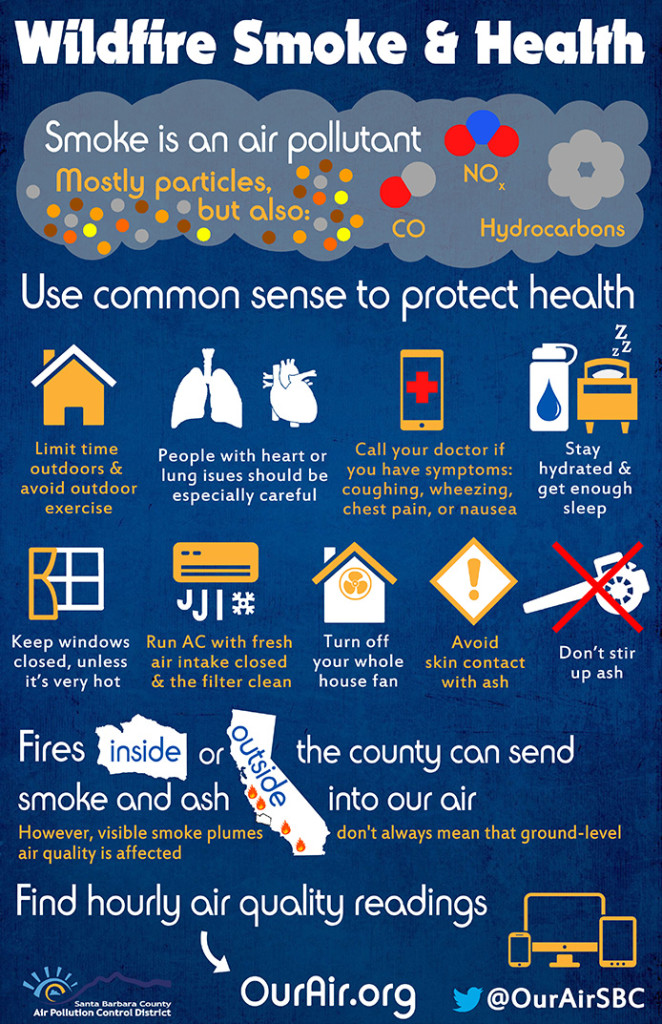Stay Informed
You can read our current advisories and get news updates 3 ways:
- Check our News and Notices page. The first column shows our news releases.
- Subscribe to advisories by entering your email address at the bottom right of this page.
- Follow us on twitter for Air Quality Advisories (@OurAirAdvisory) and News (@OurAirSBC) .
Check Today’s Air Quality for the most recent readings in your area. See below to learn what the colors mean. If you smell smoke, or see a lot of particles and ash in the air, use common sense.
The Air Quality Index (AQI) is a used to describe air quality and associated health effects. The levels and their colors are:
![]() Good – Safe for all individuals.
Good – Safe for all individuals.
![]() Moderate – Air quality is considered acceptable. Healthy individuals are unlikely to experience health effects. A small number of individuals with underlying conditions may experience health effects (acute exacerbation).
Moderate – Air quality is considered acceptable. Healthy individuals are unlikely to experience health effects. A small number of individuals with underlying conditions may experience health effects (acute exacerbation).
![]() Unhealthy for Sensitive Individuals – Vulnerable individuals may experience health effects. Healthy individuals are not likely to be affected.
Unhealthy for Sensitive Individuals – Vulnerable individuals may experience health effects. Healthy individuals are not likely to be affected.
![]() Unhealthy – Healthy individuals may begin to experience health effects. Those with underlying conditions are more likely to experience health effects, and they are more likely to be serious and require medication or seeing a provider. It would be reasonable for them to consider leaving the area. If they stay, they should avoid outdoor activity or strenuous activity.
Unhealthy – Healthy individuals may begin to experience health effects. Those with underlying conditions are more likely to experience health effects, and they are more likely to be serious and require medication or seeing a provider. It would be reasonable for them to consider leaving the area. If they stay, they should avoid outdoor activity or strenuous activity.
![]() Very Unhealthy – Healthy individuals may experience shortness of breath, coughing, irritation to the nose, throat, lungs, fatigue and heart palpitations. Those with underlying health conditions should leave the area if they are able. If they experience health effects, they are more likely to be severe and require medical attention.
Very Unhealthy – Healthy individuals may experience shortness of breath, coughing, irritation to the nose, throat, lungs, fatigue and heart palpitations. Those with underlying health conditions should leave the area if they are able. If they experience health effects, they are more likely to be severe and require medical attention.
![]() Hazardous – This is the most severe air quality rating and is an emergency condition. Even healthy individuals are likely to experience symptoms, and they could be severe and require medical attention. Those with underlying health conditions should leave the area.
Hazardous – This is the most severe air quality rating and is an emergency condition. Even healthy individuals are likely to experience symptoms, and they could be severe and require medical attention. Those with underlying health conditions should leave the area.
See also the Air Quality Index.
Everyone needs to take steps to protect themselves when pollution levels are “hazardous” and above. People most at risk from fire-related pollution include those with heart or lung disease (including asthma and chronic obstructive pulmonary disease-COPD), older adults, and children. Research indicates that pregnant women, newborns, and people with certain health conditions, such as obesity or diabetes, also may be more susceptible.
Children, particularly small children and infants, can be more affected by inhaling smoke particles than adults. Because their body mass is smaller, children exposed to the same amount of smoke as adults are more likely to have symptoms. It is important for families with small children to be aware that even if adults in the household have no symptoms, children may be experiencing them.
If you are in an at-risk group, don’t wait until pollution reaches the “hazardous” category to take action to reduce your exposure. Air quality is unhealthy for you when particle pollution levels reach the “unhealthy for sensitive groups” range, so you will need to take steps to reduce your exposure earlier and more often. If you are healthy, begin taking steps when air pollution reaches the “unhealthy” category.
Learn more about Air Pollution and Health.
Wildfire smoke can irritate your eyes, nose, throat, and lungs. It can make you cough and wheeze, and can make it hard to breathe. If experiencing severe symptoms, seek medical attention.
Sensitive Individuals
- When exposed to particle pollution, people with heart or lung diseases and older adults are more likely to visit emergency rooms, be admitted to hospitals, or in some
cases, even die. - Exposure to particle pollution may cause people with heart disease to experience chest pain, palpitations, shortness of breath, and fatigue. Particle pollution has also been associated with cardiac arrhythmias and heart attacks.
- When exposed to high levels of particle pollution, people with existing lung disease may not be able to breathe as deeply or vigorously as they normally would. They may experience symptoms such as coughing and shortness of breath. Healthy people also may experience these effects, although they are unlikely to experience more serious effects.
- Particle pollution also can increase susceptibility to respiratory diseases, such as asthma and chronic bronchitis, causing more use of medication and more doctor visits.

Protect Yourself
To reduce your exposure to smoke, stay inside an area with filtered air. Keep your windows and doors closed.
Consider setting up a “clean room” with an air cleaner that removes particles. Use a high-efficiency mechanical filter or an electrostatic precipitator. Avoid using an air cleaner that works by generating ozone, which will increase the pollution in your home. The California Air Resources Board has information on selecting portable and central air cleaners– including information on choosing the correct size for your room(s). See Tips for choosing indoor air cleaner for effective indoor smoke removal in California.
Use a particulate respirator mask when you are outside. Choose an NIOSH N95 or P100 mask with two straps and make sure it can fits snugly around your nose and chin. Surgical masks, bandanas and other paper masks do not protect your lungs from the fine particles that are of greatest concern.
Respirator masks shouldn’t be used on children or people with facial hair if they don’t seal well enough to provide protection. The key to knowing if an N95 mask fits effectively is whether an airtight seal can be created around the edges of the mask once it is on the face and pressed into place across the nose. The airtight seal around the perimeter of the mask is what determines if the mask can effectively filter particles.
See more information on Wildfire Smoke and Face Masks.
Relocate to a region with cleaner air if you are able. Even spending a few hours in clean air can improve breathing and lessen other symptoms associated with smoke exposure. Malls, movie theaters and restaurants can provide a break from smoke.
Avoid activities that make you breathe faster or more deeply. This is a good day for indoor activities, such as reading or watching TV.
Sensitive Individuals
- When exposed to particle pollution, people with heart or lung diseases and older adults are more likely to visit emergency rooms, be admitted to hospitals, or in some
cases, even die. - Exposure to particle pollution may cause people with heart disease to experience chest pain, palpitations, shortness of breath, and fatigue. Particle pollution has also been associated with cardiac arrhythmias and heart attacks.
- When exposed to high levels of particle pollution, people with existing lung disease may not be able to breathe as deeply or vigorously as they normally would. They may experience symptoms such as coughing and shortness of breath. Healthy people also may experience these effects, although they are unlikely to experience more serious effects.
- Particle pollution also can increase susceptibility to respiratory diseases, such as asthma and chronic bronchitis, causing more use of medication and more doctor visits.
Drink plenty of fluids to keep respiratory membranes moist.
Use the “recirculate” option on your vehicles’ air system, but be sure to air out your vehicle when the air quality improves.
- Avoid cleaning up ash until conditions improve and it’s safe to be outdoors.
- No one with heart or lung conditions should handle ash clean-up.
- Avoid any skin contact with ash.
- Avoid doing any activities that will stir up ash, such as using leafblowers.
- If you need to clean up ash, use damp cloths and spray areas lightly with water.
- Use vacuums with HEPA filters, and sweep gently with a broom.
- Take your car to the car wash
- Wash off toys that have been outside in the ash; clean ash off pets
- Use a high-quality shop/industrial vacuum outfitted with a high-efficiency particulate filter and a disposable collection filter bag. Ash can be bagged and put into trash cans, so it will not be stirred up again into the air. Special attachments can be used to clean ash from gutters, so that it will not blow back over outdoor spaces. Attachments and disposable bags are available from most hardware stores.
- See also Safe Ash Clean-Up During and After a Fire
Don’t add particle pollutants to your home by burning wood, gas logs or even candles or incense. Keep your home clean but don’t vacuum unless your vacuum has a HEPA filter. Wet mopping can help reduce dust. Don’t use leaf blowers.
Air out your home. Be prepared to close windows and doors again if air quality worsens.


